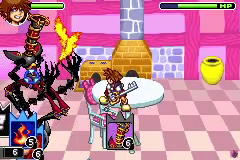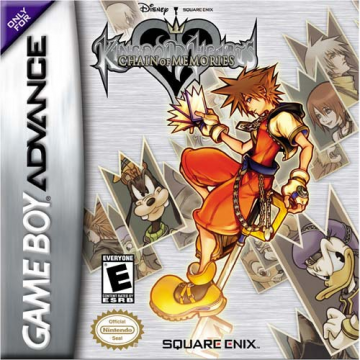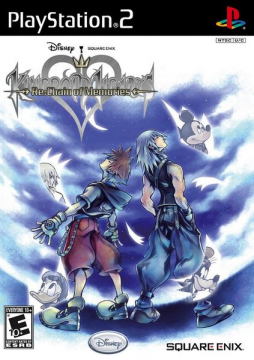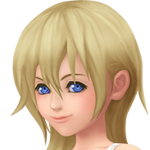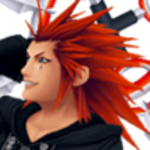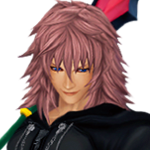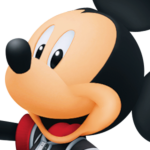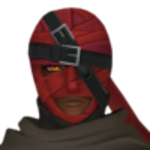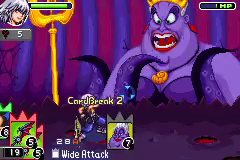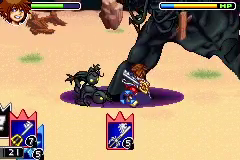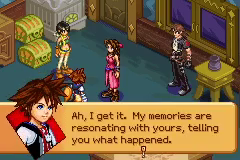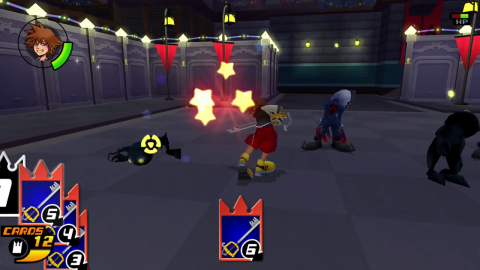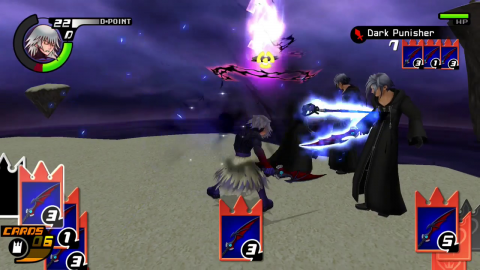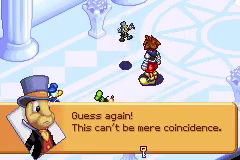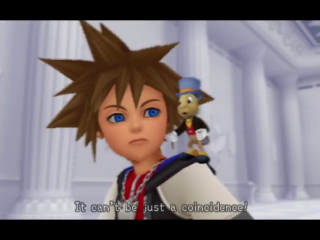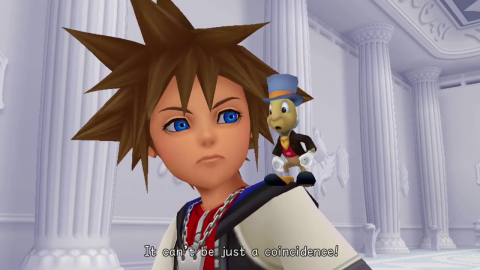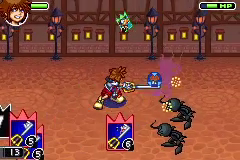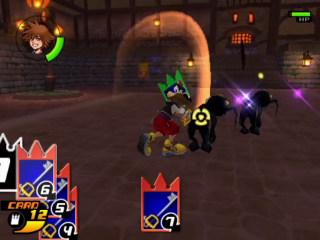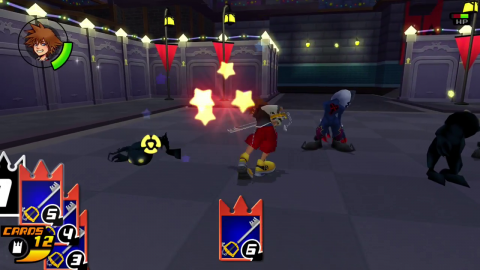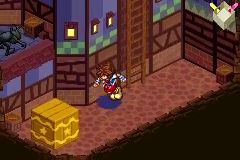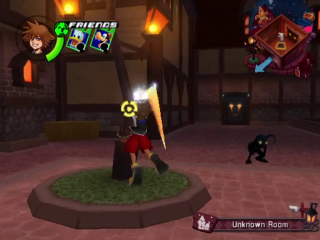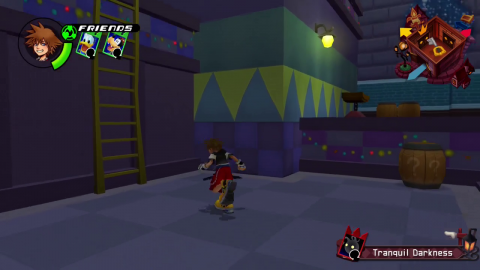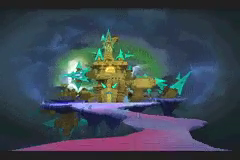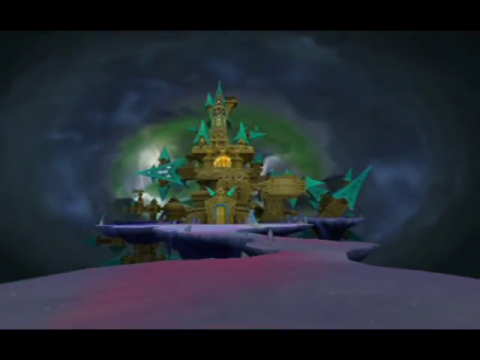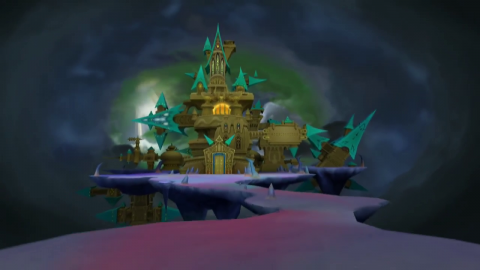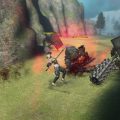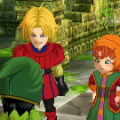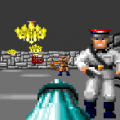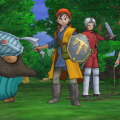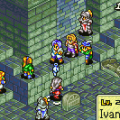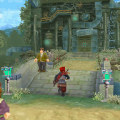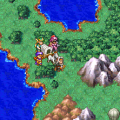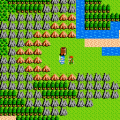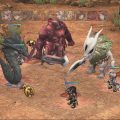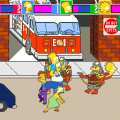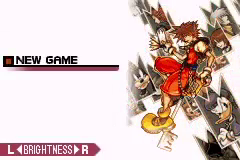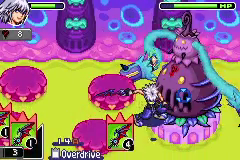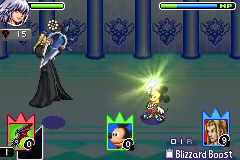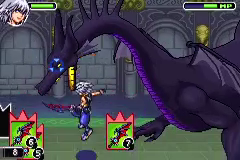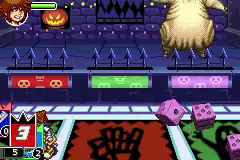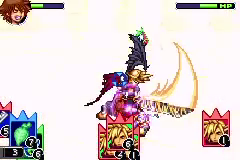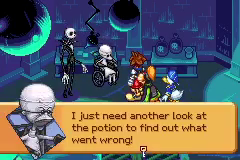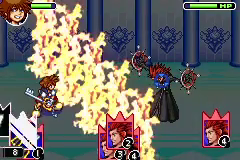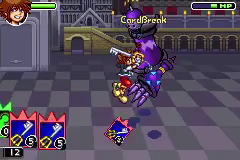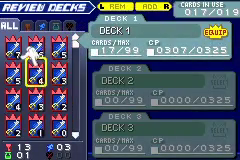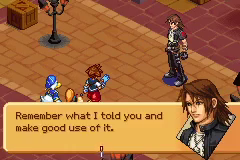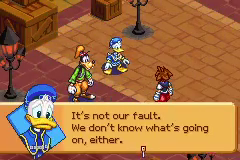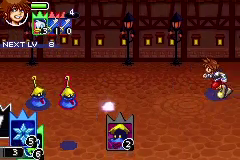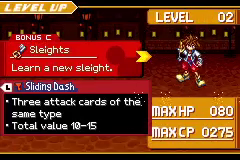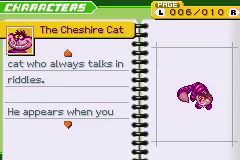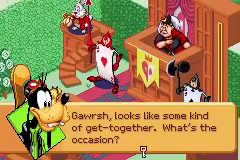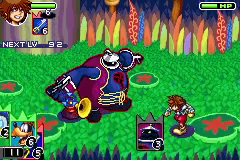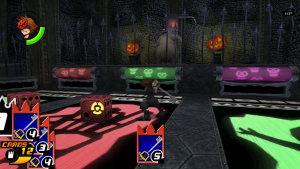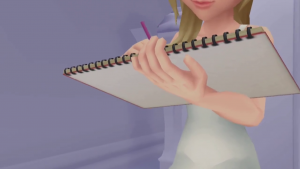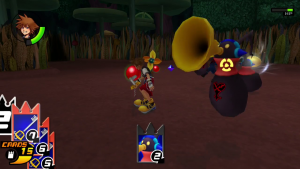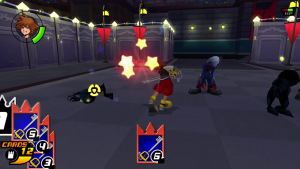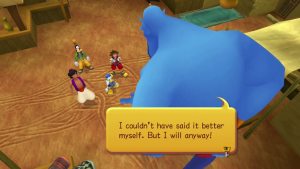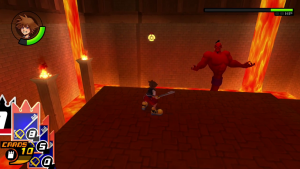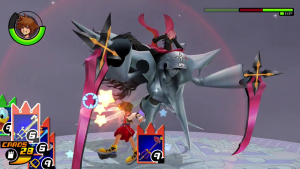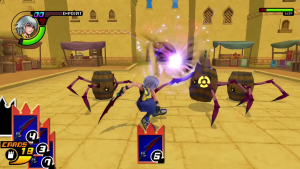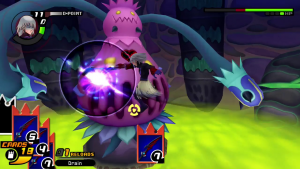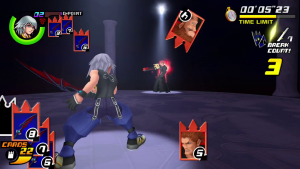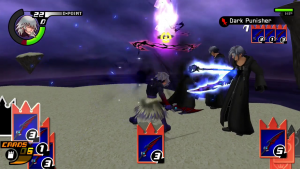- Kingdom Hearts
- Kingdom Hearts: Chain of Memories
- Kingdom Hearts II
- Kingdom Hearts: 358/2 Days
- Kingdom Hearts: Birth By Sleep
- Kingdom Hearts Re:coded
- Kingdom Hearts: Dream Drop Distance
- Kingdom Hearts χ
- Kingdom Hearts 0.2 Birth By Sleep
- Kingdom Hearts III
- Kingdom Hearts: Melody of Memory
- Kingdom Hearts (Miscellaneous)
At the end of Kingdom Hearts, Sora finds himself stranded with Donald and Goofy. The story would continue with Chain of Memories on the Gameboy Advance, which opens with a horribly compressed, pre-rendered, 3D animation, where Sora is a confronted by a figure in the same black cloak as the “Unknown” from Kingdom Hearts 1Final Mix. This stranger leads him to the surreal Castle Oblivion, where the trio’s memory begins to trickle away, but with a strange promise that “to lose is to find”.
Once the campaign is complete, the game surprises by introducing a second campaign starring Riku, playable for the first time, as he tries to wipe out the darkness inside of him. Even Mickey Mouse himself won’t be able to predict where he comes out.
Naminé
As Sora climbs the castle, he starts to remember a third friend from back on the islands, a girl who just… “disappeared,” one day. What really happened to her and how she ended up in the castle serves as the game’s central mystery.
Axel
A member of the “Organization” that runs the castle. Unlike the others, Axel seems to know Sora somehow. We soon learn he’s trying to play everyone against one another. In the real world, it’s an open secret that Axel is just an alternate take of Reno from Final Fantasy VII, and is usually voiced by the same actor in each region.
Marluxia
The lord of the castle, Marluxia is trying to guide Sora through the place for his own purposes. Hasn’t had much screen time since, but recent entries seem to be ramping up to a big return.
Mickey Mouse
King Mickey Mouse arguably doesn’t belong on a character list for the first game, since Disney only let Square use him in a single scene. After they proved themselves, Square made him a regular character. Unfortunately, he suffers from the same narrative limitations as Donald and Goofy, with highly limited character growth. When he does get to be a character, it’s usually as a foil to Riku.
DiZ / Ansem the Wise
If Marluxia is Sora’s puppetmaster, DiZ is Riku’s. In Kingdom Hearts 2, he’s revealed to be the original researcher that the villain of Kingdom Hearts 1 usurped and impersonated, leading to the unwieldy practice of referring to the two by epithet.
Kingdom Hearts: Chain of Memories began life as a turn-based, card battling game, though this premise didn’t survive the concept art phase. Still, this idea set the stage, and the final game came into existence as a sort of real-time approach to card games. The premise is incredibly hard to explain, and even the in-game tutorials are quite poor. Basically, combat takes place in arenas after running into enemies on the overworld. Sora can move around freely, but if he wants to attack, he has to use his deck of cards. This deck is never shuffled, so you want to prepare it ahead of time for your tactics. For example, the starting deck leads off with Keyblade cards, which cause Sora to take a swing. Play three in a row for his usual combo. You can move through your deck at will, so maybe you’ll move to your magic cards to use some of Sora’s spells, or an item to refresh your deck. Unfortunately, items are one-use-per-combat, and if you want to restore your cards without them, Sora has to stand still to “charge” his special Reload Card, and he’ll have to charge even longer on subsequent draws.
The cards aren’t just there to limit your actions. The game only allows one attack in play at a time: yours or the enemy’s. Each card has a number on it, 0-9, and higher numbers can break active enemy attacks, even if you’re not standing anywhere near them. 0-rank cards can break any enemy attack but can be broken by any attack in turn. You can also combine cards to use as a combination attack, adding up their numbers for a total anywhere from 0-27. Standard Heartless can never play cards higher than 9 to begin with,so this can be helpful on its own, but if you combine cards in special combinations, you get stronger attacks called Sleights. For example, combining Fire + Fire gets you the second-tier Final Fantasy spell Fira. Unfortunately, there’s a penalty: you lose the first card in each combo for the rest of the combat, and that will gradually dry out your deck!
There are other complications thrown in here. Donald, Goofy, and Disney allies only appear as random “Friend Cards,” and enemies rarely drop their own “Enemy Cards” that provide passive buffs. Sora also has to level up to carry more cards or learn more Sleights. Just getting used to regular combat will take some doing, and advanced strategies may very well take a guide. The game is incredibly poor at explaining itself, and while players who learn the advanced strategies tend to enjoy the experience, the game isn’t for everyone. Not by a long shot.
Between battles, Sora will be using an entirely different set of cards to conjure the game’s Disney worlds out of individual rooms, each of them a strange illusion cast by the castle.Each Room Card is earned from winning a combat, and has its own properties: size, shape, density of enemies, many rooms have special properties, and you won’t want to forget the “Bounty” cards that will give you a special prize once per world. To clear the plot, you have to connect these custom rooms to three gold-marked rooms on the map, and then play special story cards to progress the plot. These story doors will also demand tribute in the form of regular room cards, either cards with specific numbers, or high numbers sacrificed en masse.
This structure is broken up for the return of the Winnie the Pooh world. In the GBA version, it forms a strange obstacle course minigame, with Pooh following behind you. You’ll have to guide the silly old bear to help solve certain puzzles to unlock bonus cards.
Once Riku gets his turn, he’ll be going up against slightly different mechanics. Instead of having a customizable deck like Sora, he gets a fixed deck on each world. Some rely heavily on their attached Enemy Cards, and woe betide anyone who can’t finish a battle before the Enemy Card runs out.On the plus side, you get to keep the Enemy Cards from every boss you defeat, giving the campaign a Mega Man feel. Mind yourself: Riku can’t heal without the help of Mickey’s Friend Card or the odd Enemy Card, which really ramps up the challenge.
Riku’s big special power is Dark Mode: by breaking enemy cards, you accumulate Dark Points that will transform you into Riku’s dark, armored form from Kingdom Hearts 1. Here, your attacks change to better forms, and you gain access to Sleights that you didn’t have otherwise. Unfortunately, the form has a timer, and if the enemy breaks your cards, the timer reduces proportionally.
Despite creating brand new GBA sprites for everything in the game, the newly-minted Square Enix made the odd decision to only depict worlds, characters, and Heartless that had already appeared in Kingdom Hearts (all but the Tarzan world, because of the added trouble of negotiating with Edgar Rice Burroughs’ estate. There are also two new minor Heartless). This makes Chain of Memories the first of many “rehash” games from the series, and probably the most baffling in hindsight, since they had the perfect excuse to create new assets! The series’ habit of revisiting old worlds or sometimes even replaying old stories is contentious in the fandom, and there are four whole games that do little else. For what it’s worth, Chain of Memories‘ sprite graphics are lovely, and the music, while hindered by the GBA’s poor sound capabilities, provides perfectly serviceable renditions of Kingdom Hearts 1 tracks, plus a few new ones.
Thankfully, the game’s story is generally well-regarded, especially the GBA version with its excellent localization. Even the rehashed Disney worlds get new plots, all of which try to factor in themes from the macro plot. The core mystery is excellent, and is one of the more introspective plots in a series. It’s a shame it’s all locked behind such divisive gameplay. Unfortunately, Riku’s story is a lot thinner, with no Disney plot after the first world, but the main thread is still quality.
One last thing worth mentioning was a poorly-featured multiplayer mode exclusive to the GBA. Multiplayer only featured versus combat, and it wasn’t very interesting. This was cut from the remake.
When Kingdom Hearts 2 was given its Final Mix release, Final Mix+, Square Enix surprised everyone by attaching a free copy of a new, 3D Chain of Memories remake for PlayStation 2, called Re:Chain of Memories. This remake eventually saw standalone release as a budget title in North America, but not Europe, and was eventually included in the first HD bundle. Re:Chain of Memories is a mixed bag. The game is much slower than the original: reloading, various animations, massive arenas, and smaller AOE attacks add hours to your gameplay on empty air and glitter.Magic Sleights were downgraded when they were converted to copy-and-pasted Kingdom Hearts forms, and Summons, which were poor to begin with, lose their few quality hold-outs and might as well go unused. While the remake re-used Kingdom Hearts 1 and sometimes 2‘s assets, including Kingdom Hearts 2‘s improved facial animations, its budget North American release meant voice acting went straight down the toilet. The excellent GBA localization and experienced performers were shredded to match up with fixed lip syncing. And there are other problems. Clever gameplay gimmicks from the GBA are erased. Random card drops are less frequent, leaving you with less power to customize your deck. The remake also has a problem where, if you collect a card on the overworld but end up in a fight before the pick-up animation concludes, you lose the card! This happens more often than you’d think!
On the flip side, the remake is so much more playable in other ways. You can’t deny the convenience of scene skipping, stocking combo cards with one button instead of an easy-to-miss two, unstocking cards if you stock them by mistake, and more Slights with Donald and Goofy. The remake is better at helping you track your room cards, and adds the new “Roulette Room” to help find specifics. Customizing your deck now requires three separate buttons, and not three separate menus. There’s also a quick-access “bookmark” available in combat, though the implementation is poor. What’s frustrating is that many of these features are just fine-tuning: it’s easy to imagine a GBA revision with most of these improvements and all the GBA version’s strengths!
But the biggest changes are here for Riku. The GBA Chain of Memories treated Riku’s post-game campaign as a sort of weird challenge mode, not only with deliberately terrible, fixed decks, and the lack of Sleights outside of Dark Mode, but it even outright removed the King Mickey from your deck during two late-game worlds, severely limiting your ability to heal! In the remake, Riku’s decks are friendlier, Mickey never vanishes, and he has a whole set of new options to add variety. The biggest of these new features are Duels, where Riku starts whenever he plays a card that matches the enemy’s in value. Here, the player and enemy do a showdown of 3-7 cards, and if Riku wins, he gets to launch a powerful attack, making up for his lack of Sleights and improving a lot of the poor-quality gimmick decks.This all makes second campaign feel more fleshed-out overall.
The remake also has a small scattering of new content, chiefly a new Winnie the Pooh world more focused on minigames like in Kingdom Hearts, and an exclusive boss fight in Riku’s campaign, battling one of the Organization members who got left on the shelf in the original.
